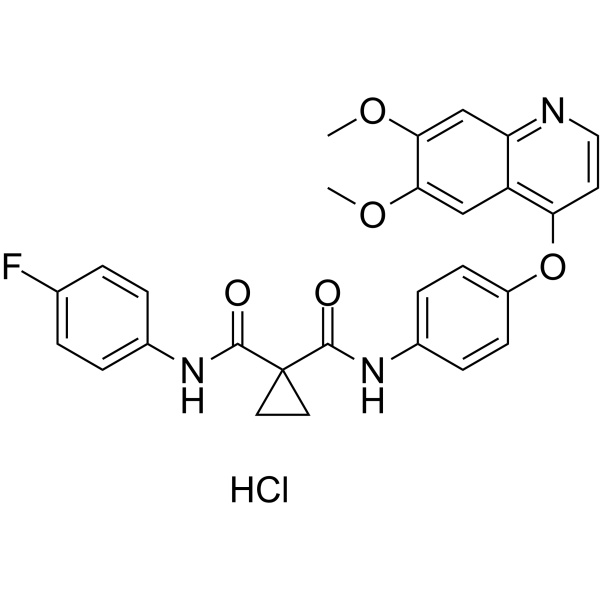Cabozantinib hydrochloride
Modify Date: 2024-01-12 08:24:35

Cabozantinib hydrochloride structure
|
Common Name | Cabozantinib hydrochloride | ||
|---|---|---|---|---|
| CAS Number | 1817759-42-4 | Molecular Weight | 537.97 | |
| Density | N/A | Boiling Point | N/A | |
| Molecular Formula | C28H25ClFN3O5 | Melting Point | N/A | |
| MSDS | N/A | Flash Point | N/A | |
Use of Cabozantinib hydrochlorideCabozantinib hydrochloride is a potent and orally active inhibitor of VEGFR2 and MET, with IC50 values of 0.035 and 1.3 nM, respectively. Cabozantinib hydrochloride displays strong inhibition of KIT, RET, AXL, TIE2, and FLT3 (IC50=4.6, 5.2, 7, 14.3, and 11.3 nM, respectively). Cabozantinib hydrochloride shows antiangiogenic activity. Cabozantinib hydrochloride disrupts tumor vasculature and promotes tumor and endothelial cell apoptosis[1]. |
| Name | Cabozantinib hydrochloride |
|---|
| Description | Cabozantinib hydrochloride is a potent and orally active inhibitor of VEGFR2 and MET, with IC50 values of 0.035 and 1.3 nM, respectively. Cabozantinib hydrochloride displays strong inhibition of KIT, RET, AXL, TIE2, and FLT3 (IC50=4.6, 5.2, 7, 14.3, and 11.3 nM, respectively). Cabozantinib hydrochloride shows antiangiogenic activity. Cabozantinib hydrochloride disrupts tumor vasculature and promotes tumor and endothelial cell apoptosis[1]. |
|---|---|
| Related Catalog | |
| Target |
VEGFR2:0.035 ± 0. nM (IC50) MET:1.3 ± 1.2 nM (IC50) METY1248H:3.8 nM (IC50) METD1246N:11.8 nM (IC50) Flt-4:6 nM (IC50) Flt-1:12 nM (IC50) |
| In Vitro | Cabozantinib hydrochloride inhibits phosphorylation of MET and VEGFR2, as well as KIT, FLT3, and AXL with IC50 values of 7.8, 1.9, 5.0, 7.5, and 42 μM, respectively[1]. Cabozantinib hydrochloride (4.6 nM) inhibits tubule formation with no evidence of cytotoxicity, with IC50 values of 6.7, 5.1, 4.1, 7.7, and 4.7 nM in HMVEC, MDA-MB-231, A431, HT1080, and B16F10 cells, respectively[1]. Cabozantinib hydrochloride (0-370 nM, 24 h) inhibits cellular migration and invasion[1]. Cabozantinib hydrochloride (48 h) inhibits tumor cell proliferation in a variety of tumor types[1]. Cell Proliferation Assay Cell Line: SNU-5, Hs746T, SNU-1, SNU-16, MDA-MB-231, U87MG, H441, H69, and PC3 cells[1] Concentration: Incubation Time: 48 hours Result: Inhibited tumor cell proliferation, with IC50 of 19, 9.9, 5223, 1149, 6421, 1851, 21700, 20200, and 10800 nM, respectively. Cell Migration Assay Cell Line: B16F10 cells[1] Concentration: 0, 41, 123, and 370 nM Incubation Time: 24 hours Result: Potently inhibited HGF-induced migration (IC50 = 31 nM) of B16F10 cells. Cell Invasion Assay Cell Line: B16F10 cells[1] Concentration: 0, 1.5, 14, and 123 nM Incubation Time: 24 hours Result: Potently inhibited HGF-induced invasion (IC50 = 9 nM) of B16F10 cells. |
| In Vivo | Cabozantinib hydrochloride (100 mg/kg, Orally, once) inhibits MET and VEGFR2 phosphorylation in mice[1]. Cabozantinib hydrochloride (100 mg/kg, Orally, once) significantly increases tumor hypoxia and apoptosis[1]. Cabozantinib hydrochloride (0-60 mg/kg, Orally, once daily for 14 days) inhibits tumor growth in a dose-dependent manner[1]. Animal Model: Female mice bearing MBA-MB-231 tumor (5 per group)[1] Dosage: 0, 100 mg/kg Administration: Orally, once Result: Inhibited MET and VEGFR2 phosphorylation. Animal Model: Mice bearing MBA-MB-231 tumor[1] Dosage: 1, 3, 10, 30, 60 mg/kg Administration: Orally, once daily for 14 days Result: Inhibited tumor growth in a dose-dependent manner. |
| References |
| Molecular Formula | C28H25ClFN3O5 |
|---|---|
| Molecular Weight | 537.97 |